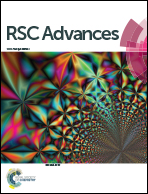Enzyme immobilization inside the porous wood structure: a natural scaffold for continuous-flow biocatalysis†
Abstract
Enzymes are often immobilized on solid supports to enable their recovery from reaction solutions, facilitate their reuse and hence increase cost-effectiveness in their application. Immobilized enzymes may even be used for flow-through applications in continuous processes. However, the synthesis of traditional immobilization scaffolds and immobilization techniques lack sustainability as they are often based on fuel-based materials and tedious synthesis- and immobilization approaches. Here, we present the natural material wood as a green alternative for enzyme immobilization. Its natural structure provides a mechanically stable porous scaffold with a high inner surface area that allows for directional flow-through of liquids. Enzymes were immobilized by nanoparticle-mediated adsorption, a simple, versatile and completely water-based process. The resulting wood–enzyme hybrids were intensely investigated for the model enzyme laccase. Reaction kinetics, as well as catalytic activities at various pH-values, temperatures, and ionic strengths were determined. The wood–enzyme hybrids could quickly and completely be removed from the reaction solution. Hence, they allow for multifold reusability. We show a series of 25 consecutive reaction cycles with a remaining activity in the last cycle of 90% of the maximal activity. Moreover, the anisotropic porosity of wood enabled the application of the hybrid material as a biocatalytic flow-through reactor. Flow-rate dependent productivity of a single-enzyme reaction was determined. Moreover, we show a two-step reaction cascade in continuous flow by the immobilization of the enzymes glucose oxidase and horseradish peroxidase. Therefore, the natural material wood proved to be a promising material for application in continuous-flow biocatalysis.



 Please wait while we load your content...
Please wait while we load your content...